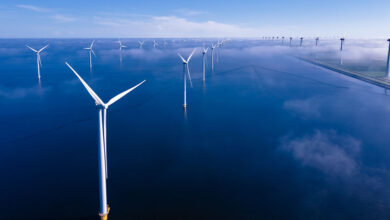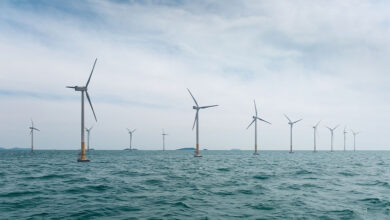EirGrid: Powering Ireland’s renewable targets

Michael Mahon, EirGrid Chief Infrastructure Officer offers an update on two key EirGrid infrastructure projects that will reinforce the network and underpin growth across the Kildare/Meath region and north Connacht.
Last month EirGrid began public consultation on a range of options for a critical, new electricity project that will reinforce the network across Kildare and Meath. The company wrote to 57,000 homes across the two counties seeking feedback on five technical solutions for the Kildare-Meath Grid Upgrade project.
The project will add a high-capacity electricity connection between Dunstown substation in Kildare and Woodland substation in Meath. The development will significantly improve the transfer and distribution of power across Meath, Kildare and surrounding counties.
The project is essential to enable the further integration of renewable energy, in line with Government policy, including the transport of electricity from offshore windfarms. It will also help meet the growing demand for electricity in the East. This growth is due to increased economic activity and the connection of new large-scale IT infrastructure in the region.
Dunstown, north of Kilcullen in Kildare, and Woodland near Dunboyne in Meath, are the end points for large amounts of power that is transported across the country on high-voltage power lines from Moneypoint in Clare. The power is produced by a large number of electricity generators in the south and south west, where many wind farms and some modern electricity generators are located.
The five options under consideration for the project are connecting and up-voltaging two existing 220 kilovolt (kV) overhead lines; a 400 kV overhead line; a 220 kV underground cable; a single 400 kV underground cable; 400 kV underground cables along two separate routes. Studies to date have indicated that the up-voltaging solution is the emerging best-performing option, with the single 400 kV underground cable as the emerging best-performing alternative.
For the up-voltaging solution, the towers and conductors on the existing circuits would be replaced or modified so they could handle a higher capacity and voltage. This option would also need new towers at some points along the route. Studies show that this option has a very good technical performance. However, it does not perform as well as an additional new circuit, which would give more operational flexibility. Its economic performance is good, and it is the overall best performer in relation to environmental and socio-economic factors, compared with the other options. This option’s environmental impact is mainly related to its construction.
A new 400 kV underground cable linking the two substations is the emerging best-performing alternative. Earlier studies questioned whether such an option would be technically feasible due to the length of the cable involved. Further investigations have shown it to be feasible. The cable would be installed in the Meath and Kildare road network. A trench up to four metres wide would be required to meet the power carrying capacity of the circuit.
This option has some technical performance advantages that other options do not. However, the amount of cable required for this option is a challenge and a risk. The operation of underground cables also needs more management than overhead lines to make sure they are safe and secure. Its economic performance is good in comparison with the other options.
Feedback from people in Kildare and Meath is critical, although the Covid-19 pandemic has presented challenges in how to engage with people due to social distancing restrictions. EirGrid have had to come up with a whole new way of consulting with people. This includes a mix of traditional and innovative, online methods, including webinars and a dedicated microsite for the project.
The project team is considering feedback on all five options before making a decision on which one to take into the next stage of this project, when EirGrid will consult about where exactly the new infrastructure will be built. This is expected to take place in 2021.
Over one third of electricity consumed in Ireland last year was produced by renewable generators, mainly wind farms, and that figure is expected to rise to 40 per cent in 2020. Under the Government’s Climate Action Plan, the figure will rise to 70 per cent by 2030. North Connacht, and other similar grid reinforcement projects, will help Ireland achieve this goal.
North Connacht
EirGrid is also currently evaluating options for a new electricity project that runs from Ballina in Mayo to Ballaghaderreen in Roscommon. The North Connacht 110 kV project is a new electricity circuit that will underpin investment in the region and facilitate the growth of renewable energy. One of the key drivers for the project is the large amount of electricity generated by wind farms in North Connacht, with more planned over the coming years.
The level of renewable generation is greater than the capacity of the local electricity network. This means that EirGrid have to look at ways at improving the electricity infrastructure in the region. Over one third of electricity consumed in Ireland last year was produced by renewable generators, mainly wind farms, and that figure is expected to rise to 40 per cent in 2020. Under the Government’s Climate Action Plan, the figure will rise to 70 per cent by 2030. North Connacht, and other similar grid reinforcement projects, will help Ireland achieve this goal.
The project has been welcomed by IDA Ireland. “Proper infrastructure is key to Ireland maintaining its international competitiveness. We must maintain an environment that is conducive to doing business – and adequate commercial energy capacity is central to that,” said Martin Shanahan, IDA Ireland Chief Executive Officer.
He added: “IDA Ireland welcomes EirGrid’s stated aim of transitioning the electricity sector to low-carbon, renewable energy. The North Connacht project is an important part of that strategy, providing the necessary electricity infrastructure required by industry across North Connacht through renewable energy means, ensuring security of supply for customers and businesses across Mayo, Sligo and Roscommon.”
It was originally proposed that a large-scale development based on 400 kV technology would be required. However, by 2017 the amount of planned renewable generation capacity in the region had dropped and a 400 kV solution was no longer required.
Instead, it was felt that the reduced amount of renewable generation could be met through a smaller development.
The project team carried out a formal consultation in 2018 and respondents raised several issues:
- The need for swift project completion;
- Route and corridor options and starting points;
- Preservation of wildlife;
- Damage to the countryside’s natural beauty;
- Noise concerns; and
- Impact on property values.
This feedback helped EirGrid in choosing a preferred technology for the project, and on the study area where it could be placed. The circuit will be either a 110 kV underground cable or overhead line that links the existing electricity substations at Moy near Ballina and Tonroe near Ballaghaderreen.
The EirGrid project team is currently evaluating possible routes for the circuit within a study area that runs from Foxford in the west to Tubercurry in the east; and Ballina in the north to Ballaghaderreen in the south. The team is currently seeking feedback on the seven potential routes identified in the study area, four of which are for overhead lines and three for underground cables.
The project is reaching a critical point where we will soon determine the best possible route. We have worked hard to reach out to people in the area who might be affected by the project. It is vitally important to receive feedback from people who may be affected by the project.
E: david.martin@eirgrid.com






